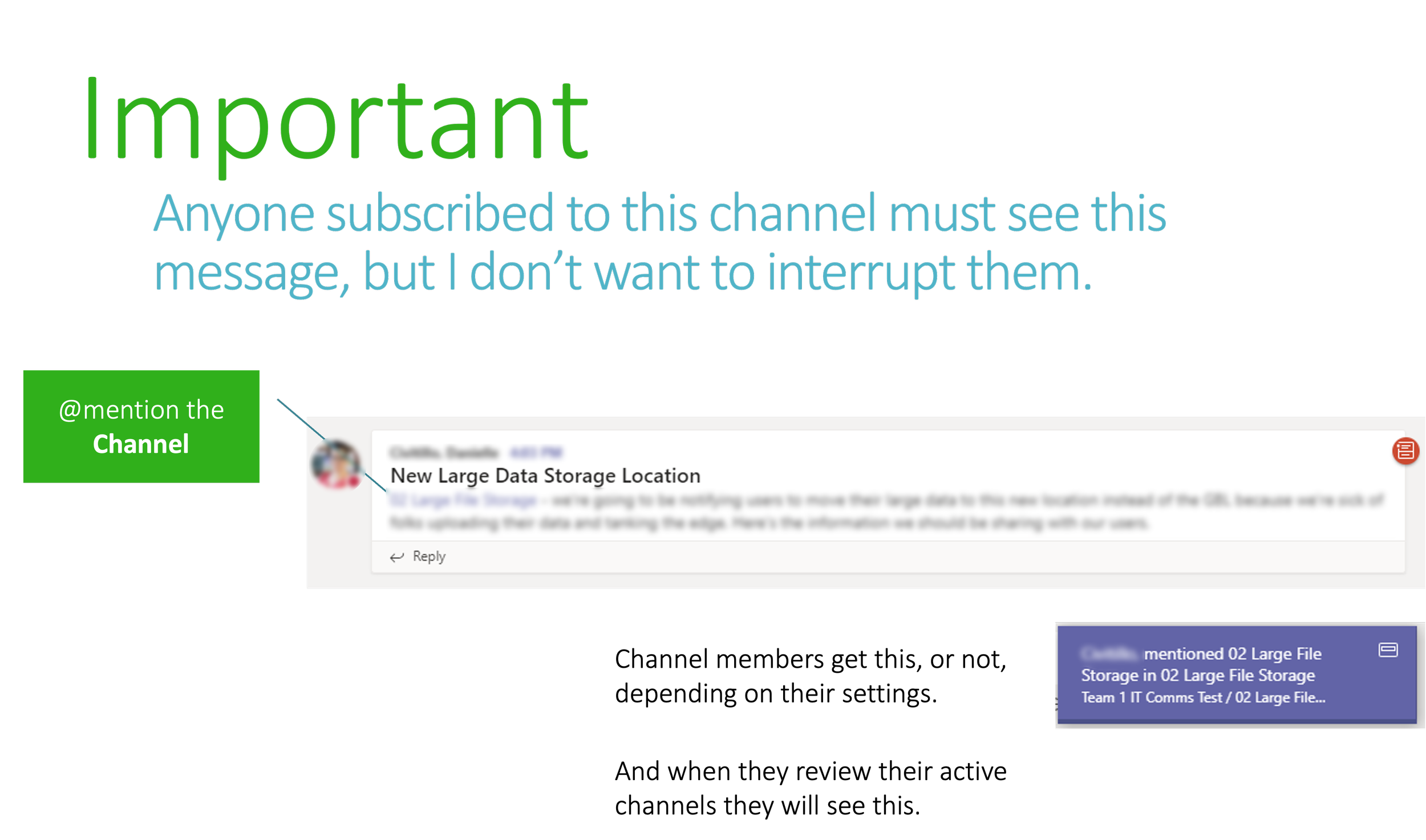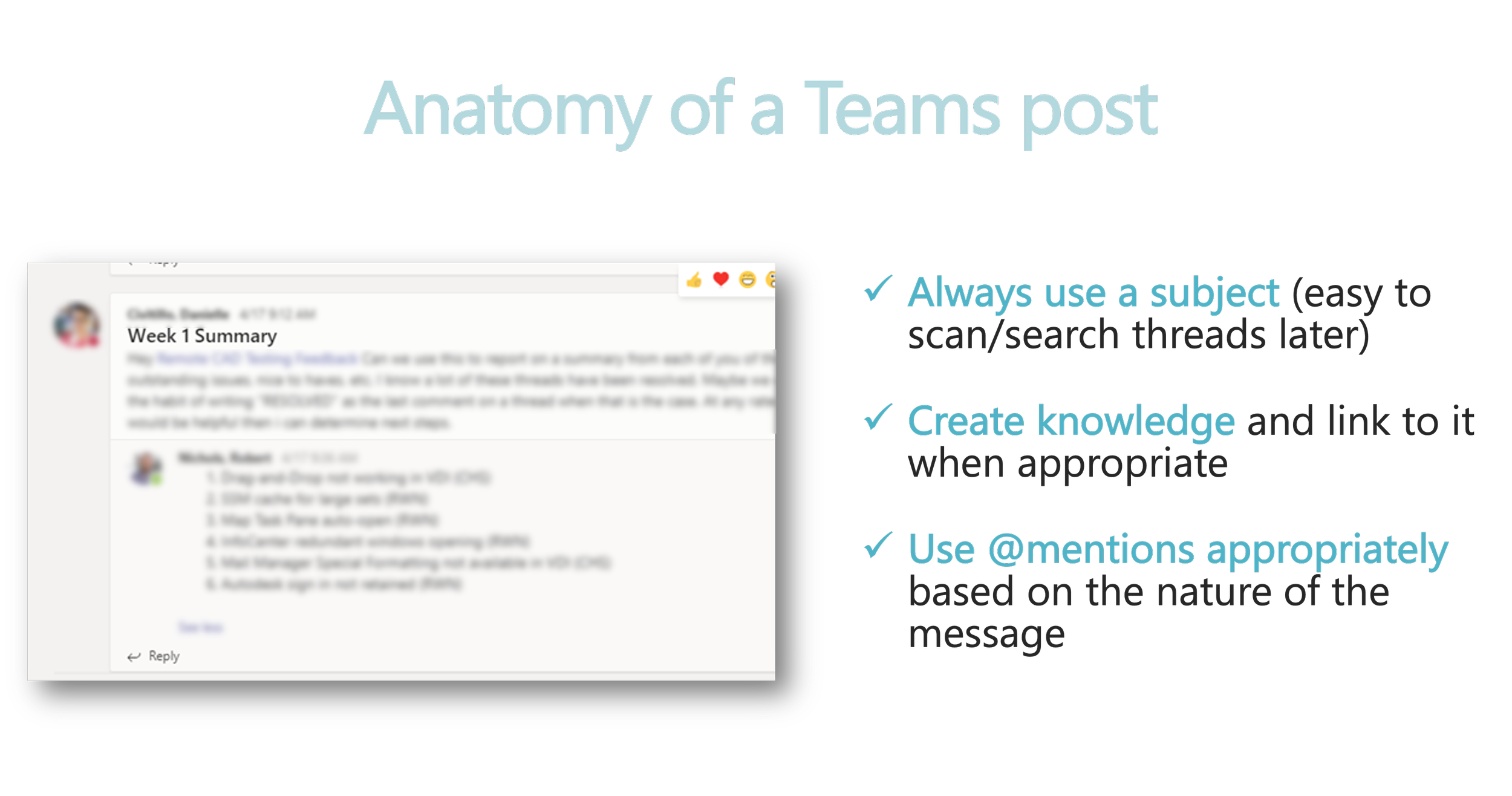VHB - How to ditch email and work in Microsoft Teams channels
When the COVID-19 pandemic hit back in early 2020, the IT department at US-based engineering, planning and design firm VHB knew Microsoft Teams was going to be a powerful tool with which to work.
They wanted to be ahead of the curve and use Teams in a purposeful and transparent way that everyone in the department agreed upon.
It started with an agreement to stick with one communication channel. The IT department committed to move off email; all department communication would switch to Microsoft Teams channels.
The next step was a shift in mindset across the entire department to work out loud in Teams. This also came with its own potential problem – constant interruption from notifications. So customising Teams notifications became a priority to allow for minimal interruptions to daily work.
For this IT department of about 45 people, transparency was important. While the IT department is split between six working teams, each with a different focus, there are times people may need access to a team they don’t actively work in.
VHB’s solution was to make everyone a member of every IT department team on Teams so they could access all information if needed. The key though, was for each person to turn down notifications for these non-essential teams. Notifications remain essential for your day-to-day team.
After a facilitated session with the whole department, VHB’s IT department’s plan looked like this:
Will Scarbrough, VHB Vice President, Digital Transformation.
“We realised the main outcome we wanted was converting to one streamlined communication channel,” said Will Scarbrough, VHB Vice President, Digital Transformation.
“Splitting our lives between email and Teams is challenging. As a group, we committed to 100% internal communications in Teams, which actually makes our life easier.”
If emails arrive from outside the IT department, they agreed to redirect those emails to a Teams channel.
After establishing these basic guidelines, the next step was to give clarity on how to post and reply. VHB’s IT department came up with three levels of messages:
Again, the key to making this work was to have Teams notifications set accordingly. The department then shared examples and further clarity on each message level.
VHB IT department’s examples of three levels of Teams messages.
Will said the emphasis in those early days of using Microsoft Teams at the start of the pandemic was to ensure everyone controls what and how they are notified on Teams.
“Some of our best practices include setting your own notifications to allow for quiet work time where you won’t be interrupted,” he said.
“When messaging a teammate, we know their response might not be instant, but they will reply. So, if someone doesn’t respond right away, remember we have a practice of checking our notifications periodically and allow people a grace period to get back to you.
“If there is a channel created where you need to be 100% on top of any new developments or updates, no matter how small or big, you can dial the notifications up so it will not only pop up in your banner but also any reply to that post will show up in both your banner and your feed.”
There are also basic tips to ensure Teams is used consistently across the department.
VHB IT department’s tips for writing a Teams post.
VHB’s IT department’s usage of Teams can be summarised by the four expectations they set themselves for how to communicate within IT.
1. Work out loud (within the right size team).
2. Quickly respond or acknowledge when you are @mentioned. For channels you follow, read what arrives.
3. Set focus time to prevent the inefficiency of multi-tasking.
4. Find the right frequency to read things you don’t follow. For channels you haven’t hidden, ones you might be interested in but don’t need to know about quickly, set a frequency such as once every other day to skim through.
VHB IT department’s Four Communication Expectations.
“You need to learn to work out loud, you need to acknowledge a response if it mentions you — even if it’s just reacting to the message to confirm you’ve seen it. If you don’t respond, it breaks down the social contract because people can’t get ahold of you,” Will said.
“You need to set your own focus times so Teams notifications don’t overwhelm you.
“And you need to occasionally catch up on other conversations in the relevant channels you’re subscribed to that are peripheral to your work.”
VHB’s IT department has been following these guidelines for working in Teams since 2020 and the data from SWOOP Analytics proves its success, with the IT department teams among all the top-performing teams on VHB’s SWOOP Analytics dashboard.
In SWOOP Analytics’ 2023 M365 & Microsoft Teams benchmarking analysis, VHB had two teams ranked in the top 1% of all active teams analysed.
Rolling out Microsoft Teams to the rest of VHB
The next step is to try rolling out the lessons learned to the rest of the 1800 employees in the organisation. Except for the IT department, Microsoft Teams is primarily used for chat across VHB. But plans are underway for that to change.
Will is working with the Director of Technical Services, Matt Kennedy, the company’s Learning and Development team, and others on the IT and design teams to implement these changes.
The process starts with Communities of Practice (CoP) within Microsoft Teams. Although it’s not something SWOOP would recommend as best practice, for numerous reasons, VHB has decided not to use Viva Engage for CoPs but to instead host CoPs on Microsoft Teams, despite a large number of people in each team.
Ken Staffier, Chief Engineer for New England Land Development at VHB, quickly learned the benefit of sharing leadership information and directives in Teams, rather than email, and before long the team on Teams had turned into a CoP for Land Development at VHB with more than 300 members.
“My messages were in the Teams platform for all to see,” Ken said.
“Searching for messages is easier than ever since they remain on Teams permanently versus an email, where maybe someone deleted it or it became cumbersome to find.
“We started finding that communicating like that was pretty fantastic and began utilising Teams more. It ended up growing into a Community of Practice almost organically because we were using it to connect with teams and receive as much information as we could.”
ROI from collaborating on Teams
Ken shared an example of how communicating and collaborating in this CoP has already led to business value and ROI.
An employee was working on a residential site and wanted to build a pickleball court for the recreation area but didn’t have details or a design to do so. They posted in Teams asking for help.
“In less than 10 minutes they had eight or 10 people responding. They were blown away by how quickly those answers came in,” Ken said.
“Whereas if that sat in somebody’s inbox, it might take them a week or two to respond and they wouldn’t have that same instantaneous connection.
“That’s the thing we’re seeing with Teams, and we want to maintain and foster it even more.”
Importantly, Ken and Senior Project Manager Karen Staffier, who both facilitate the CoP, had nothing to do with the pickleball conversation; it was an organic question and a sign of the shifting culture towards collaborating on Microsoft Teams.
They’re also planning to use the data from SWOOP Analytics for Microsoft Teams to identify the influential people within the CoP to help share messaging.
Another example of instant ROI using the CoP in Teams was when someone needed information on Electric Vehicle (EV) charging stations. Ken shared the details and documents on Microsoft Teams and within minutes others were responding with thanks because they too needed the information and were saved from searching for it elsewhere.
“If that had been an email and I had responded directly to that person, nobody else would have known about it and we would have lost the opportunity of wider info sharing,” Ken said.
“We see the power of it. We want to keep people engaged and using it because it is so helpful.”
Karen perhaps summed up the purpose of the CoP; “Helping each other builds community.”
Moving the enterprise to Microsoft Teams
The second step towards moving the rest of the company to Microsoft Teams is moving files to the correct cloud tools for each project, which totals thousands of projects each year.
“Teams is the common denominator, providing communications and live document collaboration,” Will said.
“In the future there will be a team automatically created per project, in addition to the industry cloud tools needed for that project. That space will serve as the working group for the team as well.”
Will and the IT department have learned it’s not a good idea to force everyone to switch to Teams because they won’t know how to use it well if they’re only used to email.
What will be implemented though is an agreement for each project to either communicate in email or in Teams, but not both.
Either way, the files will be accessed via Teams.
“We’re creating a training that if you’re the project manager of the team, you need to pick. Either communicate in Teams or in email but don’t do both,” Will said.
“And if you’re not comfortable yet in Teams, that’s fine, keep to email. But you have files in Teams.”














